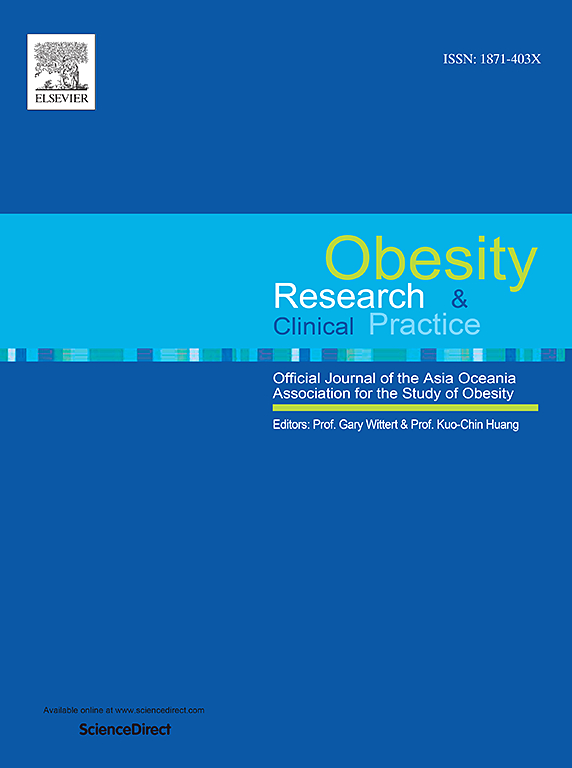多学科生活方式改变项目对超重和肥胖儿童的持续影响。
IF 2.5
4区 医学
Q3 ENDOCRINOLOGY & METABOLISM
引用次数: 0
摘要
背景:生活方式改变(LM)是治疗肥胖儿童的主要方法。本研究旨在调查参加医院LM项目的儿科队列的长期影响。方法:超重/肥胖儿童和青少年访问多学科LM项目“健康与活力诊所”。在首次访问后的6、12和18个月收集体重和身高数据。分析体重指数(BMI)和BMI z-score的变化。结果:共纳入120名5-18岁的参试者。61名完成> 1个月(最多5个月)LM项目的受试者组成LM组,而访问过一次诊所的受试者被称为医院对照(HC)组。LM组和HC组在6个月和12个月时BMI显著降低,LM组在6个月和12个月时的BMI降低幅度更大(-1.05 ± 1.46 vs -0.42 ± 1.21,p = 0.027; -0.87± 1.46和-0.14±1.43 ,分别为p = 0.038)。两组在6、12、18个月时BMI z-score均呈下降趋势,LM组在6个月时下降幅度更大(-0.33 ± 0.28 vs -0.22 ± 0.18,p = 0.019)。体重指数下降在青少年中比在儿童中更为明显,显示出体重增加随年龄的变化。结论:研究表明,在LM项目完成后,BMI和BMI z-score的持续影响。本文章由计算机程序翻译,如有差异,请以英文原文为准。
Sustained effects after a multidisciplinary lifestyle modification program for children with excess weight and children affected with obesity
Background
Lifestyle modification (LM) is the mainstay in the management of obese children. This study aimed to investigate the long-term effects of a pediatric cohort participating in a hospital-based LM program.
Methods
Overweight/obese children and adolescents who visited a multidisciplinary LM program “The Health and Vitality Clinic” were included. Data on weight and height were collected at 6, 12, and 18 months following the initial visit. The changes in body mass index (BMI) and BMI z-score were analyzed.
Results
A total of 120 participants aged 5–18 years who visited the clinic were included. Sixty-one subjects who completed > 1 months (up to a maximum of 5 months) of the LM program constituted the LM group, while those who visited the clinic once were characterized as hospital-control (HC) group. There was a significant reduction in BMI at 6 and 12 months in the LM group, and at 6 months in the HC group, with a greater reduction observed in the LM group at 6 and 12 months (-1.05 ± 1.46 vs. −0.42 ± 1.21, p = 0.027; −0.87 ± 1.46 vs. −0.14 ± 1.43, p = 0.038, respectively). Both groups showed a downward trend in BMI z-score at 6, 12, and 18 months, with the LM group showing a greater reduction at the 6 months (-0.33 ± 0.28 vs. −0.22 ± 0.18, p = 0.019). BMI decline was more pronounced in adolescents than in children, showing variations in weight gains based on age.
Conclusions
The study demonstrated lasting effects in BMI and BMI z-score following the completion of the LM program.
求助全文
通过发布文献求助,成功后即可免费获取论文全文。
去求助
来源期刊

Obesity research & clinical practice
医学-内分泌学与代谢
CiteScore
7.10
自引率
0.00%
发文量
80
审稿时长
49 days
期刊介绍:
The aim of Obesity Research & Clinical Practice (ORCP) is to publish high quality clinical and basic research relating to the epidemiology, mechanism, complications and treatment of obesity and the complication of obesity. Studies relating to the Asia Oceania region are particularly welcome, given the increasing burden of obesity in Asia Pacific, compounded by specific regional population-based and genetic issues, and the devastating personal and economic consequences. The journal aims to expose health care practitioners, clinical researchers, basic scientists, epidemiologists, and public health officials in the region to all areas of obesity research and practice. In addition to original research the ORCP publishes reviews, patient reports, short communications, and letters to the editor (including comments on published papers). The proceedings and abstracts of the Annual Meeting of the Asia Oceania Association for the Study of Obesity is published as a supplement each year.
 求助内容:
求助内容: 应助结果提醒方式:
应助结果提醒方式:


